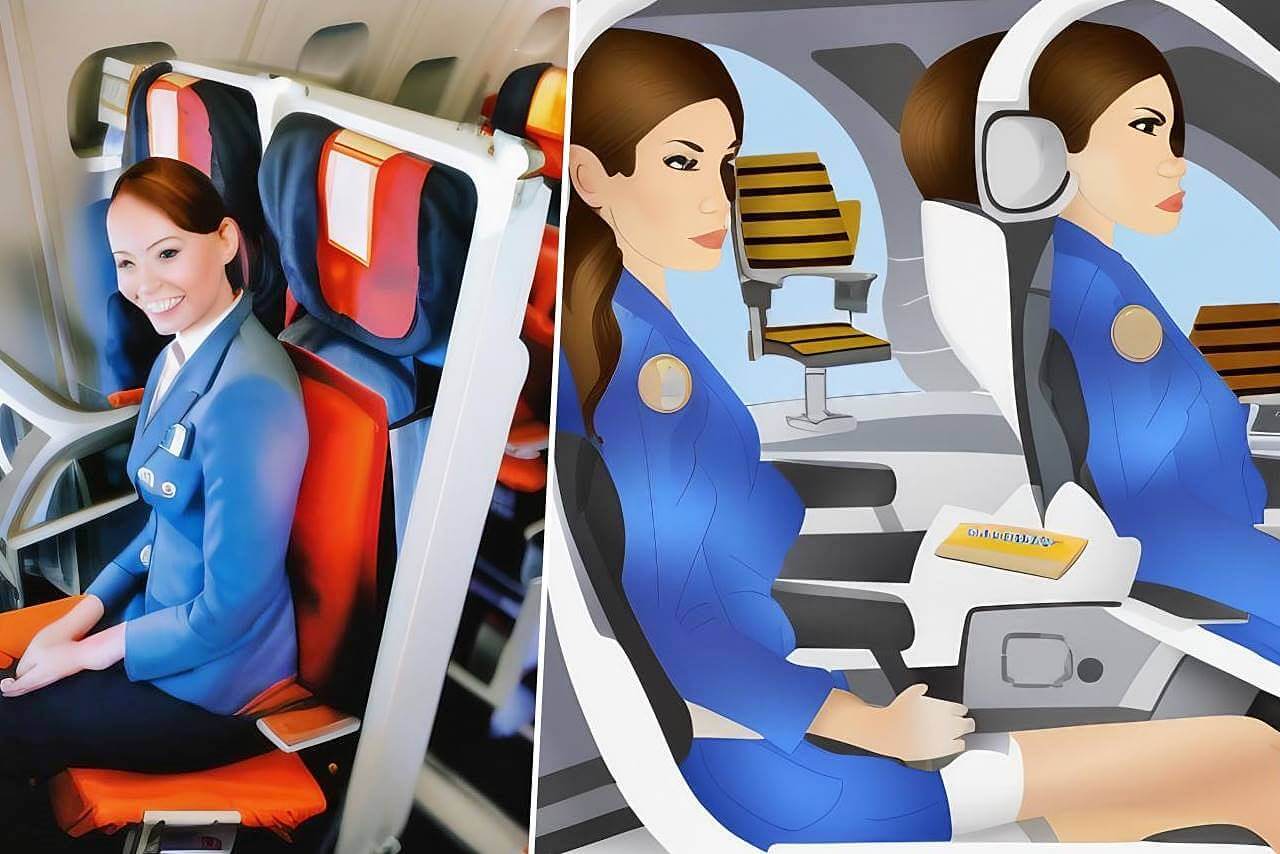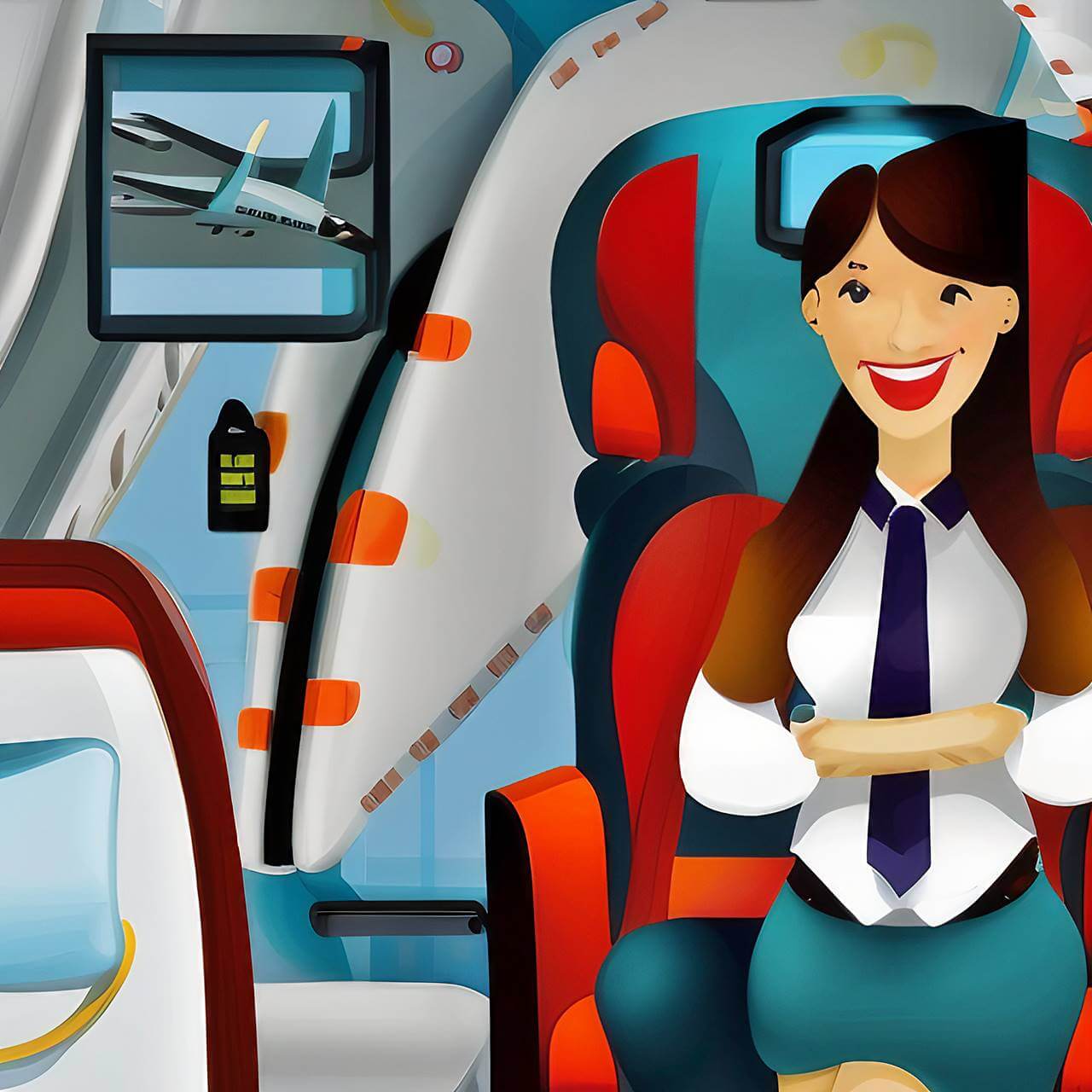The flight attendant jump seat is a seat located in the cabin of an aircraft specifically designed for use by flight attendants during takeoff, landing, and turbulence. The jump seat is typically located near the main cabin door or in the galley area and is usually foldable to save space when not in use.
Also Read: Flight Attendant Hotel Accommodation, Freebies and Discounts
Flight attendants are required to be seated and strapped in during critical phases of flight for their own safety, and the jump seat provides a designated seat for them to sit in while performing their duties.
Note: Only flight attendants are allowed to sit on a jump seat – because they are trained to use it.
Contents
- Location of the Jump Seat inside the Plane
- Purpose of a Jump Seat for Flight Attendants
- Other Plane Equipment Nearby Flight Attendants
- What is Jumpseating?
- Jumpseating Duty Flights
- Video: Understanding the Jump Seat for Flight Attendants
- Frequently Asked Questions
- 1. Where is the jump seat typically located on commercial aircraft?
- 2. What is the purpose of a jump seat for flight attendants?
- 3. What are some duties that flight attendants need to perform while using a jump seat?
- 4. Is a jump seat mandatory on commercial aircraft?
- 5. What safety regulations must flight attendants abide by while using a jump seat?
- 6. How is the jump seat folded away on commercial aircraft?
- 7. What other safety features are present on commercial aircraft?
- Summary

Location of the Jump Seat inside the Plane
The location of the jump seat on an aircraft can vary depending on the type of plane and the airline’s specific configuration. However, in general, jump seats are typically located in the cabin near the main cabin door or in the galley area.
- Commercial Airplanes – On most commercial aircraft, there are two main jump seat configurations: the forward-facing jump seat and the aft-facing jump seat. The forward-facing jump seat is located near the main cabin door, facing forward towards the cockpit. The aft-facing jump seat, as the name suggests, faces towards the rear of the aircraft and is typically located in the galley area or at the back of the cabin.
- Smaller Planes – In smaller regional aircraft, the jump seat is often located directly behind the cockpit, facing rearward. Some aircraft may also have jump seats located in the emergency exit rows, which can provide additional seating for flight attendants during takeoff and landing.
The exact location of the jump seat can vary depending on the type of aircraft, the airline’s configuration, and even the specific flight attendant’s duties. However, they are always designed to provide a safe and secure seating option for flight attendants during critical phases of flight.
Also Read: Do Cabin Crew Clean Toilets? Do Flight Attendant Clean Lavatories?
Purpose of a Jump Seat for Flight Attendants
The primary purpose of a jump seat is to provide a designated seat for flight attendants while they are performing their duties. During critical phases of flight, such as takeoff and landing, all flight attendants must be seated so that they can respond quickly and effectively in the event of an emergency. The jumpseat provides them with a secure location near the cabin door or galley area that allows them to move about the cabin safely and perform their duties if needed.
In addition to providing safety during critical times of flight, some airlines may also utilize jumpseats for transportation purposes. This allows flight attendants to travel between airports more efficiently without having to take up valuable passenger seating space. Flight attendants can usually access a jumpseat on another aircraft at their destination airport, allowing them to save time and money.
Jumpseats are an essential part of air travel operations and provide a safe and secure seating option for flight attendants during critical phases of flight. Knowing the proper use of jumpseats is important for both passengers and crew members alike, as it ensures everyone’s safety. Furthermore, utilizing jumpseats can help increase efficiency for transportation purposes, providing an important resource for both airlines and their staff.

Other Plane Equipment Nearby Flight Attendants
There is at least one jump seat on the plane. Here are some other plane equipment near the jump seat:
- Oxygen Tank – Flight attendants must always have access to an oxygen tank for safety purposes. The oxygen tank is typically located near the jump seat, allowing flight attendants to quickly and easily access it in case of an emergency.
- Emergency Exit Door – An emergency exit is typically located near the jumpseat so that flight attendants can quickly evacuate the aircraft if necessary.
- Fire Extinguisher – A fire extinguisher is usually stored nearby in case of a fire onboard the plane.
- First Aid Kit – There should be a first aid kit close to the jump seat for quick access in case of medical emergencies.
- PA System Controls – Flight attendants need to be able to control the PA system from their position near the cabin door, so these controls
- Manual Demo Kit – This contains diagrams and tools which the flight attendant can use to demonstrate safety procedures to passengers.
- Emergency Light – An emergency light is typically located near the jump seat, allowing flight attendants to easily access it in case of a power outage or smoke in the cabin.
What is Jumpseating?
Jumpseating is a procedure in which an additional crew member, such as another flight attendant or a pilot, occupies the jump seat of an aircraft during flight. The additional crew member must be certified to use the jump seat and has to be properly briefed on the rules and regulations governing its use. Jumpseating is typically done when there is an imbalance in the number of flight attendants needed for a particular flight. It also allows for more efficient staffing of flights by allowing personnel to travel between airports in order to reach their next assignment quickly and efficiently.
Safety is always the top priority when it comes to using a jump seat and only authorized personnel are allowed access to it. Flight attendants must always wear their safety harnesses while occupying the jumpseat, even if they are not actively performing duties during takeoff or turbulence. Additionally, all flight attendants must have pre-flight briefings on the proper use of a jumpseat prior to being allowed access. Furthermore, any passenger occupying the cabin area near a jumpseat must be informed that there may be a person seated in it so that they do not become startled or alarmed during flight operations.
Jumpseating is essential for efficient air travel operations and provides an important safety measure for both passengers and crew members alike. It ensures that adequate staff are available on board at all times while simultaneously allowing personnel to travel quickly between airports with minimal disruption to passengers.
Jumpseating Duty Flights
Depending on the airline, flight attendants may utilize “jump seating” as a way to travel with another carrier without having to pay for their own tickets. This practice is referred to as “jumpseating duty flights.” The jumpseat allows the cabin crew member access to go standby and still make it safely and quickly to their destination!
- For the flight attendant to be approved, the airline operator must first grant permission.
- The individual should also provide evidence of proper identification such as a valid ID, passport or any other recognition proving their identity.
- Besides that, they must demonstrate proof of employment in an air carrier company before boarding is given approval.
- After obtaining permission from the airline, flight attendants can occupy an open seat in the cabin and must follow all safety rules while doing so. No passengers or crew shall be allowed to use this chair for any reason during the flight.
Video: Understanding the Jump Seat for Flight Attendants
Check out this video from Jacqueline Travels YouTube channel where she explains all there is to know about the jump seat for cabin crew inside a plane. May you get some valuable information from it!
Frequently Asked Questions
1. Where is the jump seat typically located on commercial aircraft?
The forward-facing jump seat is usually located near the main cabin door, facing towards the cockpit, while the aft-facing jump seat is typically situated in the galley area or at the back of the cabin. In smaller regional aircraft, it may be located directly behind the cockpit, facing rearward. Some aircraft may also have jump seats located in emergency exit rows.
2. What is the purpose of a jump seat for flight attendants?
The primary purpose of a flight attendant jump seat is to provide a secure and designated seating option during the critical phases of take-off, landing, and turbulence. This allows flight attendants to monitor the cabin easily and safely during these phases while also being better prepared in case of emergencies or other unexpected events. Additionally, it can be folded away when not in use to save space within the cabin.
3. What are some duties that flight attendants need to perform while using a jump seat?
While using a jump seat, flight attendants must be able to monitor passengers during takeoff and landing; assist passengers in an emergency; prepare the cabin for takeoff and landing; serve food and drinks; and clean and restock items during flight.
4. Is a jump seat mandatory on commercial aircraft?
Yes, a jump seat is required by law to be in the main cabin of most commercial airlines. The Federal Aviation Administration requires that all flight attendants have access to a jump seat during critical phases of flight. This helps ensure the safety and security of both passengers and crew.
5. What safety regulations must flight attendants abide by while using a jump seat?
Flight attendants must follow all applicable safety regulations while using the jump seat, including ensuring their lap belts are securely fastened at all times and not obstructing any exits or pathways. Additionally, they should also familiarize themselves with emergency procedures in case of an unexpected event or aircraft malfunction.
6. How is the jump seat folded away on commercial aircraft?
The jump seat can be easily folded away when not in use to maximize space within the cabin. To do so, the flight attendant will typically pull a latch located under the seat cushion and then fold it up against the wall or into an overhead storage area. This helps ensure that passengers have enough room to move around freely throughout the flight.
7. What other safety features are present on commercial aircraft?
In addition to the jump seat, other safety features present on commercial aircraft include emergency lighting, fire suppression systems, and oxygen masks. The Federal Aviation Administration also requires every airplane to have at least two exits at each end of its main cabin to provide easy egress in case of an emergency. Additionally, commercial aircraft must also be equipped with smoke detectors and fire extinguishers to help protect passengers and crew in the event of a fire.

Summary
In conclusion, the jump seat is an important safety feature for flight attendants on commercial aircraft. It provides a secure and designated seating option during takeoff, landing, and turbulence to help ensure the safety of passengers and crew. Additionally, it can be folded away when not in use to maximize cabin space.
The Federal Aviation Administration requires that all flight attendants have access to a jump seat at all times as well as other safety features such as emergency lighting, fire suppression systems, oxygen masks, smoke detectors and fire extinguishers. By familiarizing themselves with these regulations and procedures before each flight they will be better prepared in case of any unexpected events or aircraft malfunctions while also helping keep everyone safe throughout their journey.